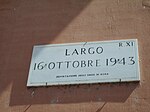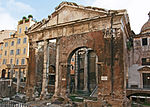Roman Ghetto
1555 establishments in the Papal States1888 disestablishments in ItalyAll accuracy disputesAntisemitism in ItalyGeography of Rome ... and 7 more
Italian Jewish communitiesJewish Italian historyJewish Roman (city) historyJewish ghettos in EuropePages containing links to subscription-only contentRome R. XI Sant'AngeloTourist attractions in Rome

The Roman Ghetto or Ghetto of Rome (Italian: Ghetto di Roma) was a Jewish ghetto established in 1555 in the Rione Sant'Angelo, in Rome, Italy, in the area surrounded by present-day Via del Portico d'Ottavia, Lungotevere dei Cenci, Via del Progresso and Via di Santa Maria del Pianto, close to the River Tiber and the Theatre of Marcellus. With the exception of brief periods under Napoleon from 1808 to 1815 and under the Roman Republics of 1798–99 and 1849, the ghetto of Rome was controlled by the papacy until the capture of Rome in 1870.
Excerpt from the Wikipedia article Roman Ghetto (License: CC BY-SA 3.0, Authors, Images).Roman Ghetto
Largo Stefano Gaj Tachè, Rome Municipio Roma I
Geographical coordinates (GPS) Address Nearby Places Show on map
Geographical coordinates (GPS)
| Latitude | Longitude |
|---|---|
| N 41.8924 ° | E 12.4775 ° |
Address
Museo Ebraico di Roma
Largo Stefano Gaj Tachè
00186 Rome, Municipio Roma I
Lazio, Italy
Open on Google Maps










